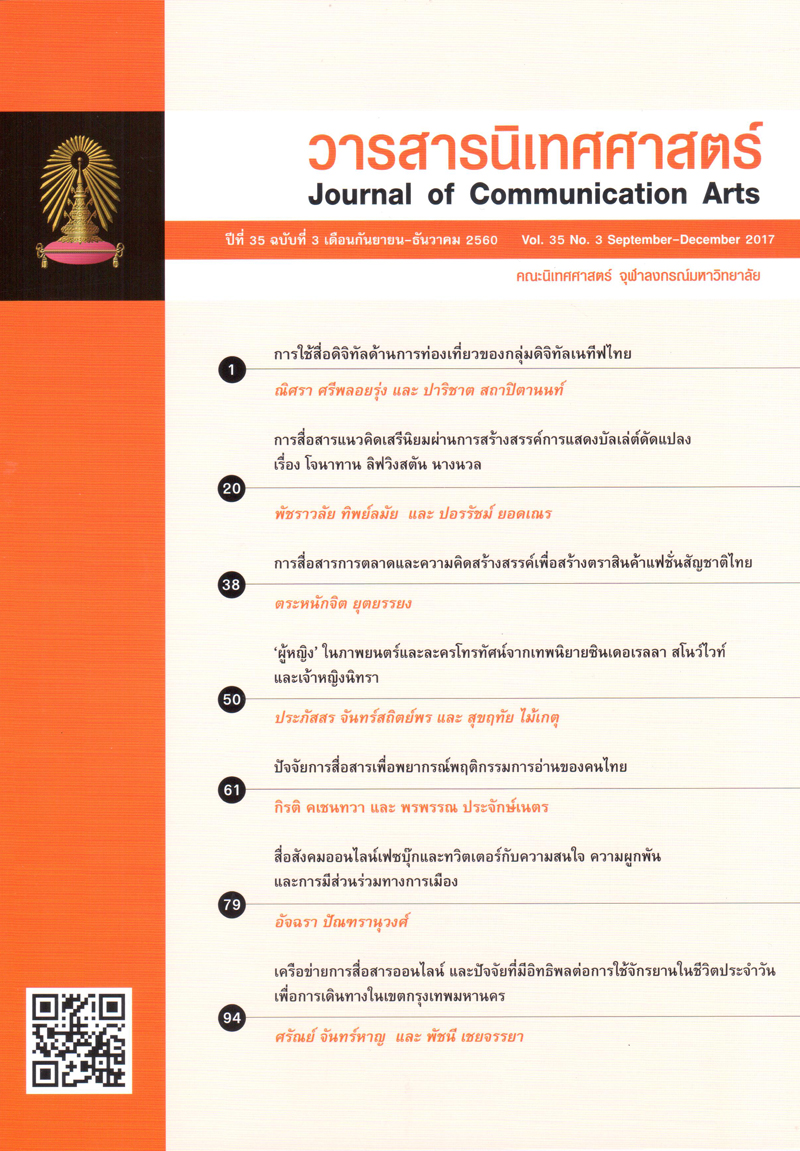‘ผู้หญิง’ ในภาพยนตร์และละครโทรทัศน์จากเทพนิยายซินเดอเรลลา สโนว์ไวท์ และเจ้าหญิงนิทรา
Main Article Content
Abstract
This research aims to study the narrative strategies, characterization of female characters, and the social ideas as reflected through the female characters in films and television series that were adapted from three fairy tales: Cinderella, Snow White and the Seven Dwarfs, and Sleeping Beauty, using qualitative textual analysis method to examine 17 films and one TV series. The research result showed the female characters in films and TV series that still fit the typical plot of fairy tale. The protagonists – Cinderella, Snow White, and Aurora, are still presented with only one side as an ideal female in typical fairy tales. Similarly, the antagonists are portrayed with only one side which reflects irrational wickedness. As for the films and TV series that have adapted different plots from the fairy tales, the protagonists were created with both gentle and strong characters, who also help the heroes in emergency. Meanwhile, the antagonists have been made to show more of their human side by presenting both their brutality and anguish. Moreover, the films also convey the ideas of divisions among races, ethnicities, and social classes, family relationships, the role of women as a mother, the role of women's sexuality, leadership, as well as the issues of power and beauty that influences women today.
Article Details
References
กรุงเทพธุรกิจออนไลน์. (2555). แมคแคนเปิดผลวิจัย ผู้หญิงใส่ใจ 5 ความงาม. สืบค้นเมื่อ
24 พฤศจิกายน 2555 จาก www.bangkokbiznews.com/home/detail/business/media/
20120519/452479
กริมม์, จาค็อบ ลุดวิก และ กริมม์, วิลเฮล์ม คาร์ล. (2502). เทพนิยายของกริมม์ (สำราญ กัลยาณมิตร, ผู้แปล). พิมพ์ครั้งที่ 2. พระนคร: แพร่พิทยา.
ไชยรัตน์ เจริญสินโอฬาร. (2555). สัญวิทยา โครงสร้างนิยม หลังโครงสร้างนิยมกับการศึกษารัฐศาสตร์. พิมพ์ครั้งที่ 2. กรุงเทพมหานคร: สำนักพิมพ์วิภาษา.
นิชธ์นาวิน จุลละพราหมณ์. (2554). สัมพันธบทในภาพยนตร์และละครโทรทัศน์อเมริกันแนวแวมไพร์ร่วมสมัย. วิทยานิพนธ์ปริญญามหาบัณฑิต, สาขาวิชานิเทศศาสตร์ คณะนิเทศศาสตร์ จุฬาลงกรณ์มหาวิทยาลัย.
นพพร ประชากุล. (2552). ยอกอักษร ย้อนความคิด เล่ม 2 ว่าด้วยสังคมศาสตร์และมนุษยศาสตร์. พิมพ์ครั้งที่ 1. กรุงเทพมหานคร: สำนักพิมพ์อ่าน.
สุญาณี ยอดดำเนิน. (2556). UN WOMEN องค์กรสตรีแห่งองค์การสหประชาชาติ. สืบค้นเมื่อ 28 เมษายน 2556 จาก http://www.learners.in.th/blogs/posts/535715.
สุวิมล วงษ์ร้ก. (2547). อัตลักษณ์และการเล่าเรื่องในภาพยนตร์รร่วมสร้างไทย-เอเชีย. วิทยานิพนธ์ปริญญามหาบัณฑิต. ภาควิชาการสื่อสารมวลชน คณะนิเทศศาสตร์ จุฬาลงกรณ์มหาวิทยาลัย
อุมาพร มะโรณีย์. (2551). สัมพันธบทของการเล่าเรื่องในสื่อการ์ตูน ละครโทรทัศน์ และ
นวนิยาย. วิทยาพนธ์ปริญญามหาบัณฑิต. ภาควิชาการสื่อสารมวลชน คณะนิเทศศาสตร์ จุฬาลงกรณ์มหาวิทยาลัย.
วันทนีย์ วาสิกะสิน. (2543). สังคมสงเคราะห์แนวสตรีนิยม ทฤษฎีและการปฏิบัติงาน. กรุงเทพมหานคร. สำนักพิมพ์มหาวิทยาลัยธรรมศาสตร์.
วารุณี ภูริสินสิทธิ์. (2545). สตรีนิยม: ขบวนการอุดมคติแห่งศตวรรษที่ 20. พิมพ์ครั้งที่ 1. กรุงเทพมหานคร: โครงการจัดพิมพ์คบไฟ.
Critic After Dark. (2012). The Sleeping Beauty (Catherine Breillat, 2010). Retrieved 2012, August 10 from http://criticafterdark.blogspot.com/2012/05/sleeping-beauty-catherine -breillat-2010.html.
Davidson, H. E. & Chaudhri, A. (2003) A Companion to the Fairy Tale. 1st ed. Cambridge: D.S. Brewer.
Hannam, J. (2007). Feminism. Harlow, England: Pearson/Longman.
Zipes, J. (2007). When Dream Came True: Classical Fairy Tales and Their Tradition.
2nd ed. New York: Routledge Taylor & Francis Group.
Sawyer, N. (2012). Feminist Outlooks at Disney Princess’s. Retrieved 2012, September 1 from www.jmu.edu/commstudies.
Shostak, R. (2008). Female Characters in Disney. Retrieved 2012, September 1 from http://shoup49.webs.com/1paperdisneyfemales.htm.
Stewart, S. (2012). Snow White becomes a girl-power icon. Retrieved 2012, September 1 from http://www.nypost.com/p/entertainment/movies/white_hot_FR4XiRR8JXNFazgPpR4DUK.


